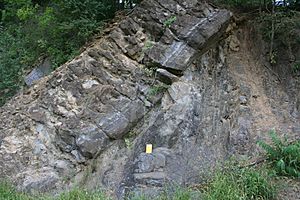Taconic unconformity facts for kids
The Taconic Unconformity is a special place in geology. It shows a big gap in the rock layers, like a missing chapter in Earth's history book! This gap was formed during a massive mountain-building event called the Taconic orogeny. You can find this amazing rock feature from eastern New York State all the way up to the Gaspe peninsula in Canada.
Contents
What is a Geological Unconformity?
A geological unconformity is a break or a gap in the rock record. Imagine layers of rock forming over millions of years, one on top of the other. An unconformity happens when some of these layers are missing. This can be because rocks were eroded away, or because no new rocks were formed for a very long time.
Why do Unconformities Happen?
Unconformities often form because of big changes on Earth. These changes can include:
- Uplift: When land is pushed up by forces inside the Earth.
- Erosion: Wind, water, and ice wearing away rocks.
- Sea level changes: When the ocean covers or uncovers land.
After a period of erosion or no new rock formation, new layers might start to form on top. The boundary between the older, missing layers and the newer ones is the unconformity.
The Taconic Orogeny: A Mountain-Building Story
The Taconic Unconformity was created by the Taconic orogeny. An "orogeny" is a fancy word for a long period of mountain building. This particular event happened a very long time ago, mostly at the end of the Ordovician period. That was about 440 to 485 million years ago!
How the Taconic Mountains Formed
During the Taconic Orogeny, huge pieces of the Earth's crust slowly crashed into each other. This intense pressure pushed up the land, creating a chain of mountains. These ancient mountains were once as tall as the Rocky Mountains or even the Himalayas are today!
What Happened to the Mountains?
Over millions of years, wind, rain, and ice slowly wore down these massive Taconic Mountains. The rocks that were eroded away were carried by rivers and deposited in other areas, forming new layers of rock. The Taconic Unconformity shows us where these old, eroded mountain roots meet younger rocks.
Where Can You See the Taconic Unconformity?
The Taconic Unconformity is exposed in several places. One famous spot is near Catskill, New York. Here, you can clearly see the older rocks from the Ordovician period below. These rocks were part of the ancient seafloor and were later uplifted and tilted. On top of them, you'll find younger rocks from the Silurian and Devonian periods. These younger rocks are often metasediments, meaning they were originally sediments that changed due to heat and pressure.
Why is the Taconic Unconformity Important?
Studying the Taconic Unconformity helps scientists understand Earth's past. It tells us:
- About ancient mountain ranges: It provides clues about how and when the Taconic Mountains formed.
- About erosion and deposition: It shows how rocks are worn away and then new ones are laid down.
- About Earth's dynamic nature: It reminds us that our planet is always changing, with land rising, falling, and eroding over vast stretches of time.
It's like finding a missing piece of a puzzle that helps us complete the picture of Earth's long and exciting geological history!


